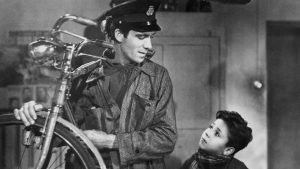Our film this week is another landmark in the history of cinema. A moving story, beautifully shot on the streets of Rome, that captures a pivotal moment in the history of Europe – and has captivated audiences and filmmakers ever since. The year is 1948. The Italian economy is in crisis. People are hungry and desperate for work.
Vittorio de Sica wanted to make a movie about a common man in these uncommon times. He took a popular novel from the day – about the breakdown of civil order in postwar Italy – and retold the story as an ode to the common man struggling against his circumstances. His film is one of the purest examples of Italian neo-realism (films taking up social issues, shot on location, often with amateur actors).
Antonio Ricci – played by Lamberto Maggiorani, a factory worker – desperately seeks work to feed his family and make a better life. All he needs is a bicycle. What better symbol of social mobility? And so we are off… The story will take us on a tour of Rome in 1948. We’ll see working class families, fortune tellers, pawnshops, beggars, markets, police stations, and sports arenas. It is a world of private dramas and public crisis.
De Sicca and his collaborators finished the screenplay just a couple days after the decisive elections of 1948 that saw the Christian Democrats triumph over the Italian Communist Party. The filming took place in a tense moment. The leader of the Communists, Palmiro Tagliatti, was shot in the street by a neo-fascist student. As he lay in a coma, unions called for massive strikes across Italy and revolution was in the air. When he came back to consciousness, he called for calm; he was a proponent of a peaceful “Italian road to socialism.” Italian public opinion would turn increasingly to France, where the Italian rider Gino Bartali led the Tour de France. Yes, the bicycle race.

